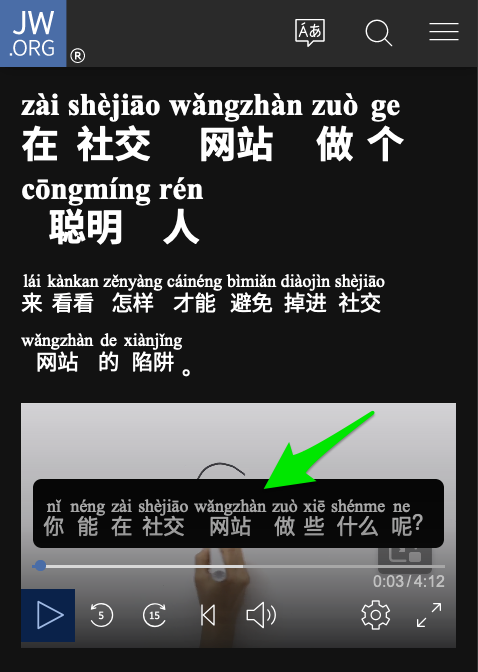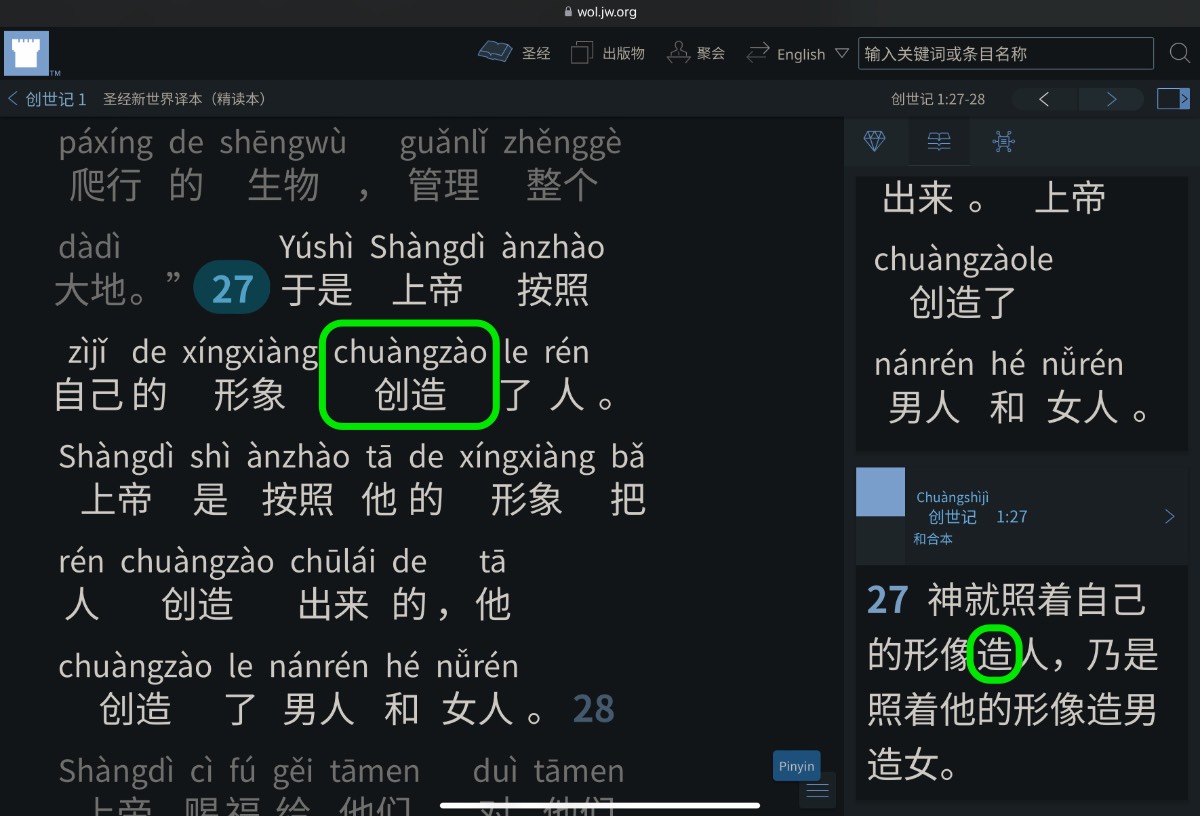shǔlíng
(shǔ·líng
{(in the) category (of)} · spirit → [spiritual (nwtsty-CHS Appx. A2 notes change from “shǔlíng” to “xīnlíng”, etc.)]
属灵
屬靈)
zhànzhēng
(zhàn·zhēng
war · contending → [war; warfare]
战争
戰爭)
← Tap/click to show/hide the “flashcard”
Lately, the organzation has often been using “xīnlíng (xīn·líng heart · spirit [→ [spiritual]] 心灵 心靈)” (MEotW post) where it used to use “shǔlíng (shǔ·líng {(in the) category (of)} · spirit → [spiritual (nwtsty-CHS Appx. A2 notes change from “shǔlíng” to “xīnlíng”, etc.)] 属灵 屬靈)”. I noticed that in at least one of the videos presented during this year’s Mandarin convention, for example. However, a recent search on the Watchtower ONLINE LIBRARY for “心灵战争” (“xīnlíng (xīn·líng heart · spirit → [spiritual] 心灵 心靈) zhànzhēng (zhàn·zhēng war · contending → [war] 战争 戰爭)”, a possible translation for “spiritual war”) returns no results at all. Searching for “心灵 战争”, with a space between the two words, returns some results, but not for the complete expression “xīnlíng (xīn·líng heart · spirit → [spiritual] 心灵 心靈) zhànzhēng (zhàn·zhēng war · contending → [war; warfare] 战争 戰爭)”. So, it seems like for now at least, “xīnlíng (xīn·líng heart · spirit → [spiritual] 心灵 心靈) zhànzhēng (zhàn·zhēng war · contending → [war; warfare] 战争 戰爭)” is not an officially used thing. However, a search on the WOL for this week’s MEotW, “shǔlíng (shǔ·líng {(in the) category (of)} · spirit → [spiritual (nwtsty-CHS Appx. A2 notes change from “shǔlíng” to “xīnlíng”, etc.)] 属灵 屬靈) zhànzhēng (zhàn·zhēng war · contending → [war; warfare] 战争 戰爭)”, did return some fairly recent results, including one from the May 2018 Watchtower.
It may just be that the English expression “spiritual war” has not come up in the organization’s production pipeline for translation into Mandarin for a while. I suppose time will tell if “xīnlíng (xīn·líng heart · spirit → [spiritual] 心灵 心靈) zhànzhēng (zhàn·zhēng war · contending → [war; warfare] 战争 戰爭)” eventually becomes a replacement translation for “shǔlíng (shǔ·líng {(in the) category (of)} · spirit → [spiritual (nwtsty-CHS Appx. A2 notes change from “shǔlíng” to “xīnlíng”, etc.)] 属灵 屬靈) zhànzhēng (zhàn·zhēng war · contending → [war; warfare] 战争 戰爭)”. For now at least, it seems that “shǔlíng (shǔ·líng {(in the) category (of)} · spirit → [spiritual (nwtsty-CHS Appx. A2 notes change from “shǔlíng” to “xīnlíng”, etc.)] 属灵 屬靈) zhànzhēng (zhàn·zhēng war · contending → [war; warfare] 战争 戰爭)” is still a relatively currently used official translation of “spiritual war”.—Ephesians 6:11, 12; 2 Corinthians 10:4, 5.
[Note, 2023-07-26: While searching the WOL for “spiritual war” returned limited post-2018 results, a more advanced search suggested by a reader turned up some more recent results, with some interesting Mandarin translations that are different from “shǔlíng (shǔ·líng {(in the) category (of)} · spirit → [spiritual (nwtsty-CHS Appx. A2 notes change from “shǔlíng” to “xīnlíng”, etc.)] 属灵 屬靈) zhànzhēng (zhàn·zhēng war · contending → [war; warfare] 战争 戰爭)”. For more information, see the next MEotW post.]
Know the Enemy
Speaking of war, many would agree that there is wisdom in this quote from Sūn Zǐ ((Sūn {Grandson (surname)} 孙 孫) (Zǐ Son’s; Child’s; Offspring’s 子) → [Sun Tzu’s]) Bīngfǎ (Bīng·fǎ Soldier’s · Way → [Art of War] 兵法) (孫子兵法, The Art of War):
If you know the enemy and know yourself, you need not fear the result of a hundred battles. If you know yourself but not the enemy, for every victory gained you will also suffer a defeat. If you know neither the enemy nor yourself, you will succumb in every battle.
With that in mind, let us consider a hypothetical scene from the command centre of Satan and the demons for their spiritual war against Jehovah and against the truth, taking place some time in the early part of the 21st century:
***
The Other Side of the Mandarin Front
Satan: Our hated Enemy Jehovah is raising up more workers for the Mandarin field. What is the state of our defences in this largest language field of all?
Demon: There is a useful government in place in China, where about 95% of all the earth’s Chinese people live. This government is intent on and efficient at suppressing all conceivable threats to its power, including religions like that of Jehovah’s people, that refuse to obey it rather than their God. This government even has a project underway to rewrite the Bible so that it serves their interests, those cheeky darlings!
Culturally, many proud, long-standing, personally inhibiting traditions are in place, making it difficult for many Mandarin-speakers to accept the truth, or to progress spiritually or otherwise as individuals if they do. (The well-known English expression “save face” was, after all, derived from a Chinese expression.)
Speaking of defences, one outstanding set of proud Chinese cultural traditions that serves as a highly effective fortification blocking the way to potential Mandarin-speaking sheep is the Great Wall of Chinese characters. This inhumanly complex system imposes extraordinary costs in the time and effort required for the simple, everyday tasks of reading and writing Chinese languages like Mandarin.

Chinese characters even put unnecessarily heavy mental loads on native speakers, causing even them to sometimes be unable to remember how to read or write even certain common characters. Unsurprisingly, then, this delightful ball and chain made of human tradition is especially highly effective at making things difficult for any whom Jehovah raises up from other language fields to work in the Mandarin field, poor unfortunate souls who have not already been learning characters all their lives.
We have observed that only about one in ten of such ones is able to cope well with the unnecessary difficulties imposed by characters. The rest struggle along at greatly reduced spiritual combat effectiveness, and the Great Wall of characters even ends up completely filtering out many who try to serve in the Mandarin field, causing them to eventually leave it and become Mandarin field casualties, as viewed by Jehovah’s side.
Satan: How about these efforts by some in Jehovah’s organization to get through and around the Great Wall of characters by making and using Pīnyīn (Pīn·yīn {Piecing Together of} · Sounds → [Pinyin] 拼音) resources? It seems that Jehovah’s organization now uses Pīnyīn (Pīn·yīn {Piecing Together of} · Sounds → [Pinyin] 拼音) more than any other organization on earth.
Demon: That may be so, but overall, the Great Wall of characters is holding. The traditions around Chinese characters are among the most deeply entrenched human cultural traditions in existence. So, Chinese characters remain the entrenched default writing system for Mandarin-speakers worldwide, and, as you know, the vast majority of humans simply accept the default systems that are presented to them, and don’t bother to think about how it could be worthwhile to find better ways of doing things. This works out great for us when people just unthinkingly adopt the religion of their parents or the morals of their peers, and it works great for us when it comes to the Great Wall of characters too.
As a result, even though Pīnyīn (Pīn·yīn {Piecing Together of} · Sounds → [Pinyin] 拼音) works fine as a simple and easy-to-use full writing system for Mandarin, and even though some in Jehovah’s organization have made extraordinary progress in making advantageous use of Pīnyīn (Pīn·yīn {Piecing Together of} · Sounds → [Pinyin] 拼音), Pīnyīn (Pīn·yīn {Piecing Together of} · Sounds → [Pinyin] 拼音) remains a cultural outlier, and Pīnyīn (Pīn·yīn {Piecing Together of} · Sounds → [Pinyin] 拼音) users continue to be ridiculed and pressured by the great majority whom we have successfully brainwashed regarding characters. Pride, tradition, and peer pressure continue to be highly effective spiritual weapons of mass destruction for us in the Mandarin field, as they are in other fronts of the spiritual war.
Satan: Excellent. There will always be pesky upstarts among Jehovah’s people who challenge the human traditions that serve us so gloriously well, and Jehovah may even help them, but it deeply satisfies my great unholy anger to see that we are keeping them suppressed so effectively. Carry on.
***
Don’t like seeing Satan’s spiritual war plans working out in the Mandarin field? Then fight back with spirit and truth and reject obstructive human traditions that make it much harder than necessary to serve God in the Mandarin field, “so that we may not be overreached by Satan, for we are not ignorant of his designs.”—John 4:23, 24; 2 Corinthians 2:11.

